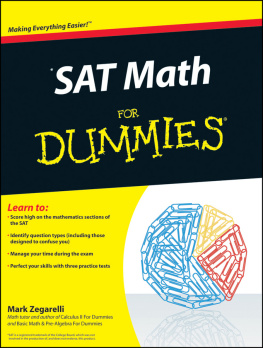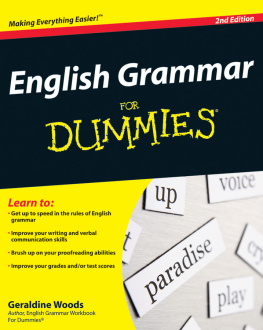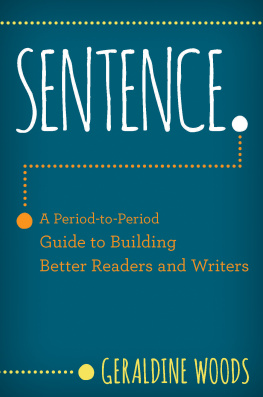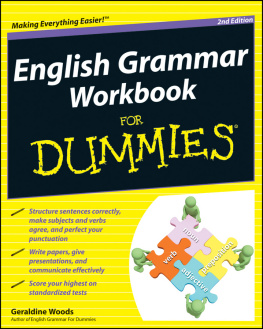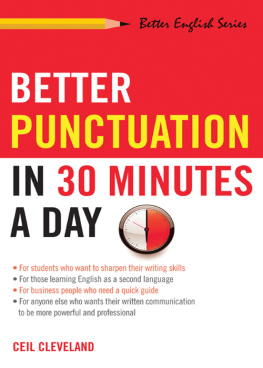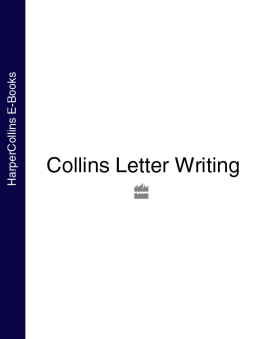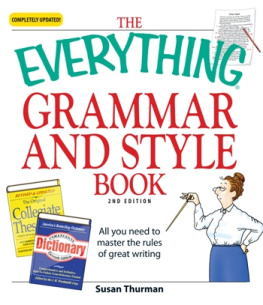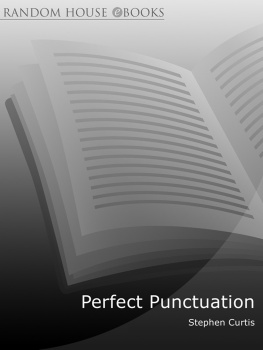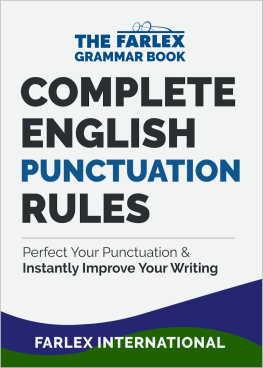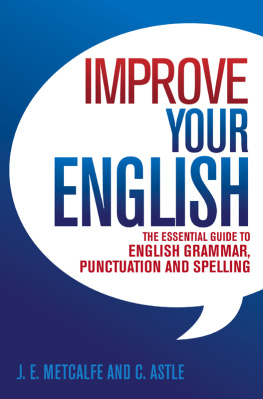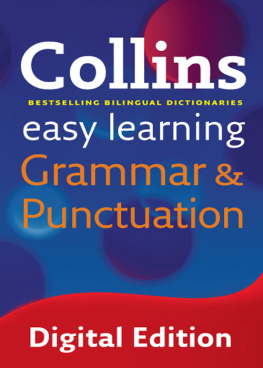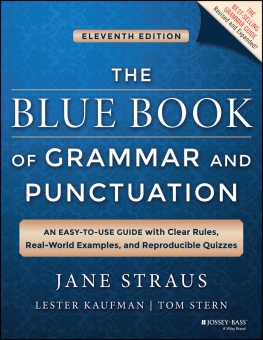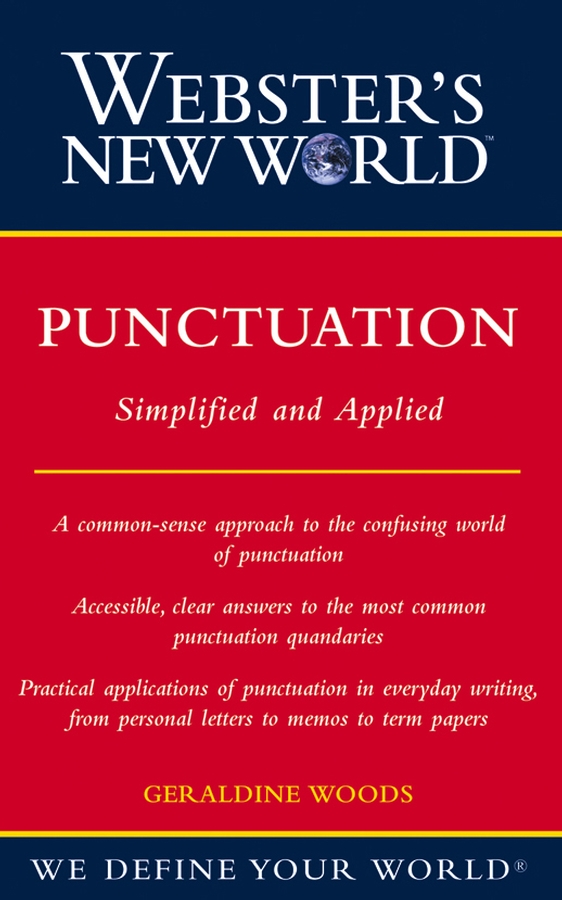Contents

For Kyra, the first of the next generation.
Websters New World Punctuation: Simplified and Applied
Copyright 2006 by Wiley, Hoboken, NJ
Published by Wiley, Hoboken, NJ
Published simultaneously in Canada
No part of this publication may be reproduced, stored in a retrieval system, or transmitted in any form or by any means, electronic, mechanical, photocopying, recording, scanning, or otherwise, except as permitted under Sections 107 or 108 of the 1976 United States Copyright Act, without either the prior written permission of the Publisher, or authorization through payment of the appropriate per-copy fee to the Copyright Clearance Center, 222 Rosewood Drive, Danvers, MA 01923, 978-750-8400, fax 978-646-8600, or on the web at www.copyright.com . Requests to the Publisher for permission should be addressed to the Legal Department, Wiley Publishing, Inc., 10475 Crosspoint Blvd., Indianapolis, IN 46256, 317-572-3447, fax 317-572-4355, or online at http://www.wiley.com/go/permissions .
The publisher and the author make no representations or warranties with respect to the accuracy or completeness of the contents of this work and specifically disclaim all warranties, including without limitation warranties of fitness for a particular purpose. No warranty may be created or extended by sales or promotional materials. The advice and strategies contained herein may not be suitable for every situation. This work is sold with the understanding that the publisher is not engaged in rendering legal, accounting, or other professional services. If professional assistance is required, the services of a competent professional person should be sought. Neither the publisher nor the author shall be liable for damages arising herefrom. The fact that an organization or Website is referred to in this work as a citation and/or a potential source of further information does not mean that the author or the publisher endorses the information the organization or Website may provide or recommendations it may make. Further, readers should be aware that Internet Websites listed in this work may have changed or disappeared between when this work was written and when it is read.
Trademarks: Wiley, the Wiley Publishing logo, Websters New World, the Websters New World logo, and all related trademarks, logos, and trade dress are trademarks or registered trademarks of John Wiley & Sons, Inc. and/or its affiliates. All other trademarks are the property of their respective owners. Wiley Publishing, Inc. is not associated with any product or vendor mentioned in this book.
For general information on our other products and services or to obtain technical support, please contact our Customer Care Department within the U.S. at 800-762-2974, outside the U.S. at 317-572-3993, or fax 317-572-4002.
Wiley also publishes its books in a variety of electronic formats. Some content that appears in print may not be available in electronic books. For more information about Wiley products, please visit our web site at www.wiley.com .
Library of Congress Cataloging-in-Publication Data:
Woods, Geraldine.
Websters New World punctuation : simplified and applied / Geraldine Woods.
p. cm.
ISBN-13: 978-0-7645-9916-3 (isbn-13 : pbk.)
ISBN-10: 0-7645-9916-X (isbn-10 : pbk.)
1. English languagePunctuationHandbooks, manuals, etc. I. Title. PE1450.W66 2006
428.2dc22
2005023688
Introduction
A popular French entertainer once explained that a kiss can be a comma, a question mark, or an exclamation point. This sort of punctuation easily attracts interest, but until recently many grammarians and copy editors assumed that their passion for a properly placed semicolon was rare. Yet a substantial number of people do care about punctuation and would indeed like to know, for example, when a comma is called for. Moreover, everyone should care because punctuation is the roadmap that tells the reader how to arrive at the writers meaning.
Imagine that a worried student goes to a fortuneteller for advice about an important exam and receives this note:
The way you are studying you will take the test and pass not experiencing a miserable failure.
How is the student to react? Should the worrier open the book and study madly in an effort to avert disaster? Should the student, reassured by the prediction, take in a movie instead? The answer depends on the punctuation:
The way you are studying, you will take the test and pass, not experiencing a miserable failure.
The way you are studying, you will take the test and pass not, experiencing a miserable failure.
The preceding example illustrates what American writer Edgar Allan Poe meant when he said, The writer who neglects punctuation, or mispunctuates, is liable to be misunderstood. The primary reason to place a punctuation mark in your text is to clarify the message, making sure that the reader grasps what you are trying to say.
Proper punctuation, like good grammar, has another purpose as well. The quality of your writing influences the impression you make on your boss, your teacher, or your personal correspondents. A job application letter or a note to a childs teacher that is marred by punctuation errors will, rightly or wrongly, make you less likely to be taken seriously. The reverse is also true: to attract and keep the readers serious attention, you must writeand therefore punctuatecorrectly.
Learning how to punctuate is relatively easy these days, but such was not always the case. The modern system of punctuation did not become standardized until the late 18th century. The preference of individual writers and printers determined the placement of punctuation, not the needs of the reader. In the works of Shakespeare, for example, periods, colons, and semicolons appear with seemingly little reason for one rather than the other. At various times polite but fierce battles broke out over the standards and practices of various punctuation marks. Thomas Jefferson, as he wrote the Declaration of Independence, joined a long-running dispute over apostrophes, placing an apostrophe in its (the possessive pronoun) in that document. In Jeffersons draft, the new government was organizing its powers. The non-apostrophists eventually won their point, and Jefferson was obliged to omit the apostrophe from its .
Jeffersons struggle illustrates an important point about punctuation: Each little symbol gets its meaning from an agreement between readers and writers. Educated people today have decided that the possession shown by the word its may be turned into a contraction with the addition of an apostrophe ( its ). Thus, its and its have different meanings. Had the standard been decided otherwise, its might have fulfilled both functions.
Although many punctuation rules clarify meaning, some exist for no reason at all apart from custom. With meaning not at stake, you may wonder why a writer should worry about where to place the period or whether a comma belongs inside or outside the quotation marks. The value of these punctuation customs is the sense of stability they provide. Seeing the period inside some quotation marks and outside others in the same piece of writing would be disconcerting. Proper punctuation works on an almost subconscious level. It guides the reader to the intended meaning without becoming too intrusive. Variations catch attention and distract the reader from the writers message. So arbitrary or not, punctuation customs are worth learning.
Unfortunately, the rules for punctuation are still not completely uniform. They change over time and according to location. Years ago writers placed far more commas and semicolons in their work than modern writers do. Also, punctuation sometimes varies depending on country or context. British and American writers follow different rulesand even use different namesfor some punctuation marks. Scientists customs differ from historians, and business has its own traditions.



